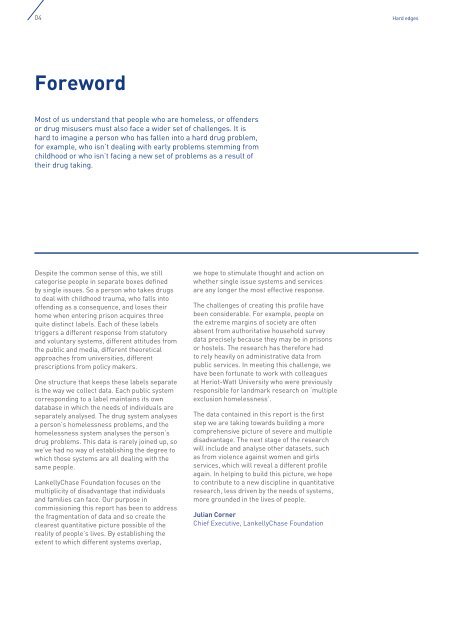Hard_Edges_Mapping_SMD_FINAL_VERSION_Web
Hard_Edges_Mapping_SMD_FINAL_VERSION_Web
Hard_Edges_Mapping_SMD_FINAL_VERSION_Web
You also want an ePaper? Increase the reach of your titles
YUMPU automatically turns print PDFs into web optimized ePapers that Google loves.
04 <strong>Hard</strong> edges<br />
Foreword<br />
Most of us understand that people who are homeless, or offenders<br />
or drug misusers must also face a wider set of challenges. It is<br />
hard to imagine a person who has fallen into a hard drug problem,<br />
for example, who isn’t dealing with early problems stemming from<br />
childhood or who isn’t facing a new set of problems as a result of<br />
their drug taking.<br />
Despite the common sense of this, we still<br />
categorise people in separate boxes defined<br />
by single issues. So a person who takes drugs<br />
to deal with childhood trauma, who falls into<br />
offending as a consequence, and loses their<br />
home when entering prison acquires three<br />
quite distinct labels. Each of these labels<br />
triggers a different response from statutory<br />
and voluntary systems, different attitudes from<br />
the public and media, different theoretical<br />
approaches from universities, different<br />
prescriptions from policy makers.<br />
One structure that keeps these labels separate<br />
is the way we collect data. Each public system<br />
corresponding to a label maintains its own<br />
database in which the needs of individuals are<br />
separately analysed. The drug system analyses<br />
a person’s homelessness problems, and the<br />
homelessness system analyses the person’s<br />
drug problems. This data is rarely joined up, so<br />
we’ve had no way of establishing the degree to<br />
which those systems are all dealing with the<br />
same people.<br />
LankellyChase Foundation focuses on the<br />
multiplicity of disadvantage that individuals<br />
and families can face. Our purpose in<br />
commissioning this report has been to address<br />
the fragmentation of data and so create the<br />
clearest quantitative picture possible of the<br />
reality of people’s lives. By establishing the<br />
extent to which different systems overlap,<br />
we hope to stimulate thought and action on<br />
whether single issue systems and services<br />
are any longer the most effective response.<br />
The challenges of creating this profile have<br />
been considerable. For example, people on<br />
the extreme margins of society are often<br />
absent from authoritative household survey<br />
data precisely because they may be in prisons<br />
or hostels. The research has therefore had<br />
to rely heavily on administrative data from<br />
public services. In meeting this challenge, we<br />
have been fortunate to work with colleagues<br />
at Heriot-Watt University who were previously<br />
responsible for landmark research on ‘multiple<br />
exclusion homelessness’.<br />
The data contained in this report is the first<br />
step we are taking towards building a more<br />
comprehensive picture of severe and multiple<br />
disadvantage. The next stage of the research<br />
will include and analyse other datasets, such<br />
as from violence against women and girls<br />
services, which will reveal a different profile<br />
again. In helping to build this picture, we hope<br />
to contribute to a new discipline in quantitative<br />
research, less driven by the needs of systems,<br />
more grounded in the lives of people.<br />
Julian Corner<br />
Chief Executive, LankellyChase Foundation


